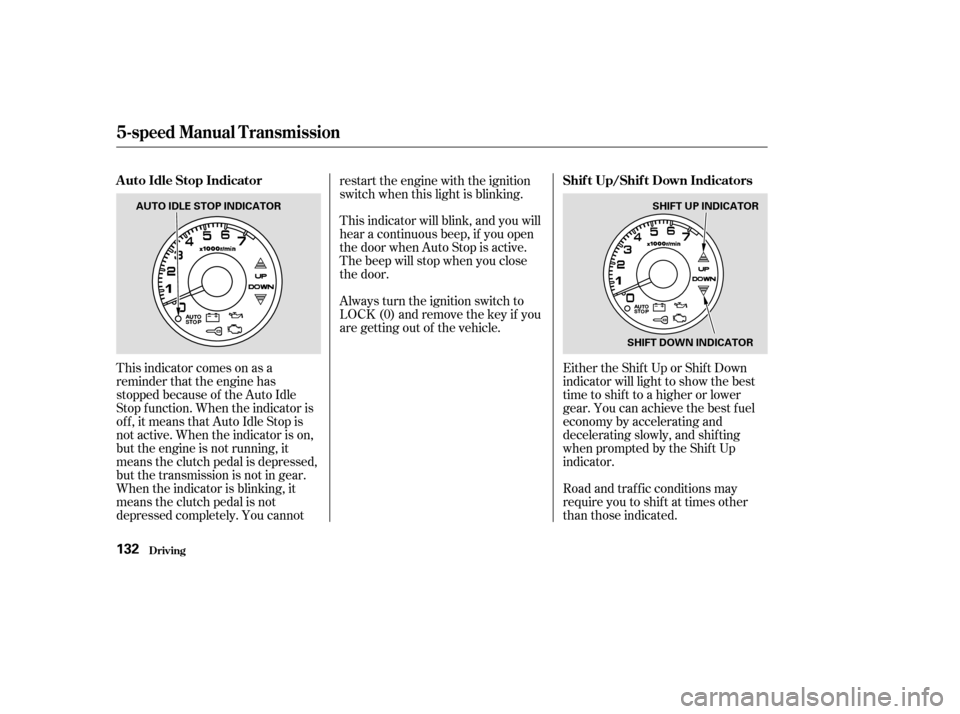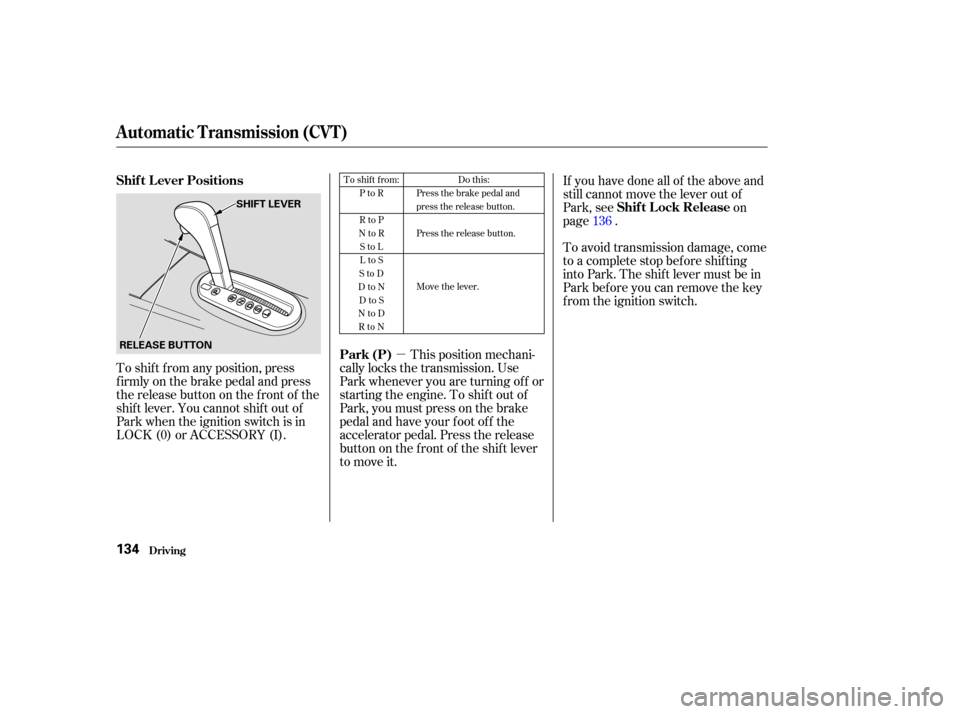Page 122 of 231

Always maintain your vehicle
according to the maintenance
schedule. See(see page
).
an underinf lated tire
causes more ‘‘rolling resistance,’’
which uses f uel. Try to maintain a constant speed.
Everytimeyouslowdownand
speed up, your vehicle uses extra
fuel.Usethecruisecontrolwhen
appropriate.
Combine several short trips into
one.
The air conditioning puts an extra
load on the engine which makes it
usemorefuel.Usethefresh-air
ventilation when possible.
Drive moderately. Rapid
acceleration, abrupt cornering and
hard braking use more f uel.
Always drive in the highest gear
possible.
You may find that your Civic Hybrid’s
unique combination of an engine and
an electric motor has driving
characteristics that are somewhat
dif f erent f rom what you are used to.
Shif t Up and Shif t Down indicators
(5-speed manual transmission only)
on the instrument panel show when
to shif t to a higher or lower gear. By
shifting as soon as the indicator
comes on, you will keep the engine
operating in its most economical
range.
Engine oil also af f ects f uel
economy. The f uel ef f icient, low-
viscosity 0W-20 oil recommended
f or your Civic Hybrid is
f ormulated to help the engine use
less f uel. This oil is available at
your Honda dealer.
The build-up of snow or mud on
your vehicle’s underside adds
weight and rolling resistance.
Frequent cleaning helps your f uel
mileage and reduces the chance of
corrosion. 146
For example,
CONT INUED
Improving Fuel Economy
Owner’s
Maintenance Checks
Fuel Economy
Bef ore Driving119
Page 130 of 231
This section gives you tips on
starting the engine under various
conditions, and how to operate the
5-speed manual and automatic
transmissions. It also includes impor-
tant inf ormation on parking your
vehicle, and the braking system.........................
Preparing to Drive .128
.......................
Starting the Engine .129
....
5-speed Manual Transmission . 130
.
Automatic Transmission (CVT) . 133
...........................................
Parking .139
.............................
Braking System .140
...............
Anti-lock Brakes (ABS) . 141
...........................
Towing a Trailer .142
Driving
Driving127
Page 132 of 231

Apply the parking brake.
In cold weather, turn of f all
electrical accessories to reduce
the drain on the battery.
Push the clutch pedal down all the
way.
Make sure the shif t lever is in
Park. Press on the brake pedal.
Without touching the accelerator
pedal, turn the ignition key to the
START (III) position. Do not hold
the key in START for more than
15 seconds at a time. If the engine
does not start right away, pause
f or at least 10 seconds bef ore
trying again.If the engine does not start within
15 seconds, or starts but stalls
right away, repeat step 4 with the
accelerator pedal pressed halfway
down. If the engine starts, release
pressure on the accelerator pedal
so the engine does not race.
If the engine fails to start, press
the accelerator pedal all the way
downandholdittherewhile
starting to clear flooding. If the
engine still does not start, return
to step 5.
In cold weather, conventional starter
is used instead of the IMA system
starter. This is normal. The engine is
also harder to start at altitudes above
8,000 f eet (2,400 meters) because of
the thinner air.
1.
2.
3.
4. 5.
6.
Manual Transmission:
Automatic Transmission (CVT)
Starting the Engine
Driving
Starting in Cold Weather
129
Page 133 of 231

The manual transmission is syn-
chronizedinallforwardgearsfor
smooth operation. It has a lockout so
you cannot shift directly from Fifth
to Reverse. When shif ting up or
down,makesureyoupushtheclutch
pedal down all the way, shift to the
next gear, and let the pedal up
gradually. When you are not shif ting,
do not rest your f oot on the clutch
pedal. This can cause your clutch to
wear out faster.Come to a full stop before you shift
into Reverse. You can damage the
transmission by trying to shif t into
Reverse with the vehicle moving.
Push down the clutch pedal, and
pause f or a f ew seconds bef ore
shif ting into Reverse, or shif t into
one of the f orward gears f or a
moment. This stops the gears so
they won’t ‘‘grind.’’
When slowing down, you can get
extra braking f rom the engine by
shifting to a lower gear. This extra
braking can help you maintain a safe
speed and prevent your brakes f rom
overheating while going down a
steep hill. Bef ore downshif ting,
make sure the vehicle speed is low
enough that you will not activate the
engine speed limiter in the lower
gear. Make sure the engine speed
will not go into the tachometer’s red
zone in the lower gear bef ore
downshif ting.
If you exceed the maximum speed
f or the gear you are in, the engine
speed will enter into the tachometer’s
red zone. If this occurs, you may f eel
the engine cut in and out. This is
caused by a limiter in the engine’s
computer controls. The engine will
run normally when you reduce the
RPM below the red zone.
Bef ore downshif ting, make sure the
engine will not go into the
tachometer’s red zone.
5-speed Manual T ransmission
Driving
Engine Speed L imiter
130
Rapid slowing or speeding-up
can cause loss of control on
slippery surfaces. If you crash,
you can be injured.
Use extra care when driving on
slippery surfaces.
Page 135 of 231

This indicator will blink, and you will
hear a continuous beep, if you open
the door when Auto Stop is active.
The beep will stop when you close
the door.
Always turn the ignition switch to
LOCK (0) and remove the key if you
are getting out of the vehicle.
This indicator comes on as a
reminder that the engine has
stopped because of the Auto Idle
Stop f unction. When the indicator is
of f , it means that Auto Idle Stop is
not active. When the indicator is on,
but the engine is not running, it
means the clutch pedal is depressed,
but the transmission is not in gear.
When the indicator is blinking, it
means the clutch pedal is not
depressed completely. You cannot restart the engine with the ignition
switch when this light is blinking.
Either the Shift Up or Shift Down
indicator will light to show the best
time to shift to a higher or lower
gear. You can achieve the best f uel
economy by accelerating and
decelerating slowly, and shif ting
when prompted by the Shif t Up
indicator.
Road and traffic conditions may
require you to shif t at times other
than those indicated.
5-speed Manual T ransmission
A uto Idle Stop Indicator Shif t Up/Shif t Down Indicators
Driving132
AUTO IDLE STOP INDICATOR SHIFT UP INDICATOR
SHIFT DOWN INDICATOR
Page 136 of 231
Honda’s Continuously Variable
Transmission’s unique design
provides a smooth, constant f low of
power. It is electronically controlled
f or more precise operation and
better f uel economy.These indicators on the instrument
panel show which position the shif t
lever is in.The ‘‘D’’ indicator comes on f or a
f ew seconds when you turn the
ignition switch to ON (II). If it
f lashes while driving (in any shif t
position), it indicates a possible
problem in the transmission. Avoid
rapid acceleration and have the trans-
mission checked by a Honda dealer
as soon as possible.
Continuously Variable
T ransmission (CVT )
Shif t L ever Position Indicators
Automatic Transmission (CVT)
Driving133
Page 137 of 231

�µ
To shif t f rom any position, press
f irmly on the brake pedal and press
the release button on the front of the
shiftlever.Youcannotshiftoutof
Park when the ignition switch is in
LOCK (0) or ACCESSORY (I). To avoid transmission damage, come
to a complete stop bef ore shif ting
into Park. The shif t lever must be in
Park bef ore you can remove the key
from the ignition switch.
This position mechani-
cally locks the transmission. Use
Park whenever you are turning of f or
starting the engine. To shif t out of
Park, you must press on the brake
pedal and have your f oot of f the
accelerator pedal. Press the release
buttononthefrontof theshiftlever
to move it. If you have done all of the above and
still cannot move the lever out of
Park, see
on
page . 136
To shift from:
PtoR
RtoP
NtoR StoL
LtoS
StoD
DtoN DtoS
NtoD RtoN Do this:
Press the brake pedal and
press the release button.
Press the release button.
Move the lever.Shif t L ever Positions
Park (P) Shif t L ock Release
Automatic Transmission (CVT)
Driving134
SHIFT LEVER
RELEASE BUTTON
Page 138 of 231

�µ
�µ
�µ �µ
�µ
Press the brake
pedal and press the release button to
the f ront of shif t lever to shif t f rom
Park to Reverse. To shif t f rom
Reverse to Neutral, come to a
completestopandthenshift.
Use Neutral if you
need to restart a stalled engine, or if
it is necessary to stop brief ly with
the engine idling. Shif t to the Park
position if you need to leave your
vehicle for any reason. Press on the
brake pedal when you are moving
the shift lever from Neutral to
another gear.
Use this position f or
your normal driving. The transmis-
sion automatically selects a suitable
gear f or your speed and acceleration.
You may notice the transmission
shif ting up at higher speeds when
the engine is cold. This helps the
engine warm up f aster. Selecting Second
shifts the transmission into a lower
range of ratios for better
acceleration and increased engine
braking. Use Second when you are
going down a steep hill, or in stop-
and-go driving.
To shif t to Low, press
the release button on the front of the
shif t lever. Use Low to get more
power when climbing, and f or
maximum engine braking when
going down steep hills.
ForfasteraccelerationwheninD,S
or L, the transmission will
automatically ‘‘kick down’’ to a lower
range of ratios by pushing the
accelerator pedal to the floor. When the vehicle reaches the
maximum speed in any shif t position,
you may f eel the engine cut in and
out. This is caused by a limiter (112
mph, 180 km/h) in the engine’s
computer controls. The engine will
run normally when you reduce the
speed to below the maximum.
Reverse (R)
Neutral (N)
Drive (D) Second (S)
Low (L)
Engine Speed L imiter
Automatic Transmission (CVT)
Driving135